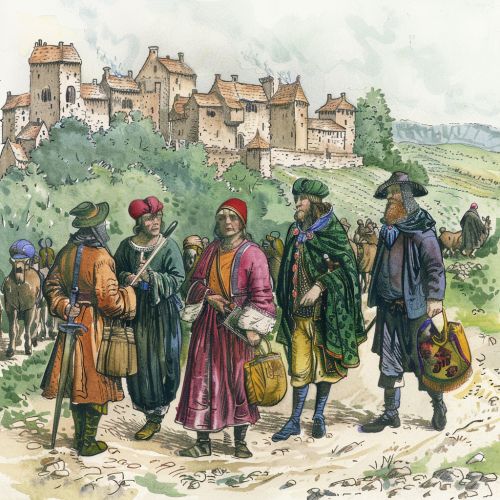Chaucer: Difference between revisions
(Created page with "== Early Life and Background == Geoffrey Chaucer, born circa 1343, is widely regarded as the Father of English literature. His life and works have had a profound impact on the English language and its literary tradition. Chaucer was born into a family of vintners in London, which afforded him a relatively comfortable upbringing. His father, John Chaucer, was a prosperous wine merchant, and his mother, Agnes Copton, was an heiress. This background provided Chaucer with t...") |
No edit summary |
||
| Line 23: | Line 23: | ||
"The Canterbury Tales" is notable for its use of the English vernacular, rather than Latin or French, which were the dominant literary languages of the time. This choice helped to elevate English as a legitimate language for literary expression. The work also showcases Chaucer's mastery of various literary forms, including [[fabliau]], [[romance]], and [[exemplum]]. | "The Canterbury Tales" is notable for its use of the English vernacular, rather than Latin or French, which were the dominant literary languages of the time. This choice helped to elevate English as a legitimate language for literary expression. The work also showcases Chaucer's mastery of various literary forms, including [[fabliau]], [[romance]], and [[exemplum]]. | ||
[[Image:Detail-79375.jpg|thumb|center|Illustration of pilgrims from The Canterbury Tales.]] | |||
=== Other Major Works === | === Other Major Works === | ||
Revision as of 06:22, 18 May 2024
Early Life and Background
Geoffrey Chaucer, born circa 1343, is widely regarded as the Father of English literature. His life and works have had a profound impact on the English language and its literary tradition. Chaucer was born into a family of vintners in London, which afforded him a relatively comfortable upbringing. His father, John Chaucer, was a prosperous wine merchant, and his mother, Agnes Copton, was an heiress. This background provided Chaucer with the opportunity to receive a good education, likely at the St. Paul's Almonry, where he would have been exposed to the classics and the works of Ovid and Virgil.
Career and Royal Service
Chaucer's career began in the service of the royal court. By 1357, he was a page in the household of Elizabeth de Burgh, Countess of Ulster. This position marked the beginning of his lifelong association with the English court. In 1359, during the Hundred Years' War, Chaucer was captured by the French and later ransomed. His release was secured by King Edward III, indicating his value and connections within the court.
In 1366, Chaucer married Philippa Roet, a lady-in-waiting to Queen Philippa of Hainault. This marriage further cemented his ties to the royal court. Over the years, Chaucer held various positions, including Controller of Customs for the Port of London and Clerk of the King's Works. These roles not only provided him with financial stability but also exposed him to a wide array of social classes and individuals, which would later influence his literary works.
Literary Works
Early Works
Chaucer's early works were heavily influenced by French and Italian literature. His first major work, "The Book of the Duchess," written around 1369, is an elegy for Blanche of Lancaster, the wife of John of Gaunt. This poem showcases Chaucer's early use of dream vision as a literary device, a technique he would employ in later works.
Another significant early work is "The House of Fame," written between 1374 and 1385. This poem explores themes of fame, fortune, and the nature of poetry itself. It is notable for its use of allegory and its reflection on the poet's role in society.
The Canterbury Tales
Chaucer's most famous work, "The Canterbury Tales," was written in the late 14th century. This collection of stories is presented as part of a storytelling contest by a group of pilgrims traveling to the shrine of Thomas Becket in Canterbury. The tales are told by a diverse group of characters, each representing different segments of medieval society. This structure allows Chaucer to explore a wide range of themes, including love, betrayal, and social satire.
"The Canterbury Tales" is notable for its use of the English vernacular, rather than Latin or French, which were the dominant literary languages of the time. This choice helped to elevate English as a legitimate language for literary expression. The work also showcases Chaucer's mastery of various literary forms, including fabliau, romance, and exemplum.

Other Major Works
In addition to "The Canterbury Tales," Chaucer wrote several other important works. "Troilus and Criseyde," written in the 1380s, is a tragic love story set during the Trojan War. This poem is considered one of Chaucer's greatest achievements, showcasing his ability to blend classical sources with contemporary themes.
Another significant work is "The Parliament of Fowls," a dream vision poem that explores themes of love and marriage. Written around 1382, this poem is notable for its use of rhyme royal, a seven-line stanza form that Chaucer helped to popularize.
Influence and Legacy
Chaucer's influence on English literature cannot be overstated. His works helped to shape the development of the English language and its literary tradition. By writing in the vernacular, Chaucer made literature accessible to a broader audience and demonstrated the expressive potential of English.
Chaucer's use of character and narrative structure in "The Canterbury Tales" has had a lasting impact on the development of the novel and short story forms. His ability to create vivid, multi-dimensional characters set a precedent for future writers.
